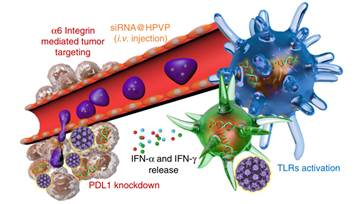Professor Zhang Xianzheng’s team (College of Chemistry and Molecular Sciences, Wuhan University) has been committed to the research of applying polymer materials to bio-medicine. Based on previous accumulations, the research group recently proposed the concept of Material-Assisted Microorganisms (MAMO), which makes the complementary advantages of microbes and nanomaterials to achieve better treatment of diseases (Figure 1). Following this assumption, the team has recently made a series of progress in bio-medicine, with related findings published in authoritative journals, including Nature Biomedical Engineering, Nature Communications, Science Progress, Advanced Materials and Angewandte Chemie International Edition.

Figure 1: diagram of Material-Assisted MicroOrganisms
On July 6, Nature Biomedical Engineering published online Prof. Zhang Xianzheng’s latest findings on the therapy of kidney failure with biomedical materials. The paper is entitled An Orally Delivered Microbial Cocktail for the Removal of Nitrogenous Metabolic Waste in Animal Models of Kidney Failure. Wuhan University is the only undersigned unit of the article. The corresponding author is Zhang Xianzheng, and two co-first authors are doctoral candidates Zheng Diwei and Pan Pei.
Kidney failure has become one of the most worrisome public health problems. If kidney failure deteriorates to the terminal stage, patients need invasive dialysis to remove nitrogenous wastes from the blood. However, hemodialysis costs much and brings serious side effects with great limitations. Thus, it is extremely important to find a non-invasive method to eliminate nitrogen-containing toxins accumulated in patients with kidney failure. Zhang Xianzheng’s group developed a mixture of calcium alginate micrococcal bacteria coated with polydopamine. The researchers separated three strains of bacteria that can degrade nitrogenous waste urea and creatinine into amino acids from mice feces, and prepared them through microfluidic technology and chemical in-situ polymerization. The bacterial microecosystem (BME) enters the body through oral medication, and the polydopamine membrane layer controls nitrogen-containing micro-molecules in the intestine to selectively enter into the microspheres, which are metabolized and decomposed by bacteria. In this way, the nitrogenous wastes can be removed from the blood through metabolic regulation in the intestine, and consequently kidney failure alleviates. This non-invasive treatment method has achieved notable therapeutic effects among a variety of animal models (Figure 2), and few obvious adverse reactions were found in the entire preclinical study.

Figure 2: diagram of BME to remove metabolic wastes and relieve kidney failure
Colorectal cancer is one of the most common types of cancer. Intestinal flora play a vital role in the development and treatment of colorectal cancer. Zhang Xianzheng’s group reported a targeted nanomedicine mediated by a phage for regulating the intestinal flora and enhancing the effect of tumor chemotherapy. They screened out a temperate phage that can specifically inhibit Fusobacteriumnucleatum, and combined the phage and dextran nanoparticles loaded with chemotherapeutic drugs to form a phage-mediated nanomedicine through a bioorthogonal reaction. Experiments show that this nanomedicine can not only inhibit the proliferation of Fusobacteriumnucleatum, but also effectively reduce the tolerance of colorectal cancer to chemotherapy, thus increasing the content of short-chain fatty acids such as butyric acid in the intestine. Moreover, the nanomedicine in animal bodies can inhibit the growth of Clostridium nucleatum and meanwhile promote the proliferation of endogenous butyrate-producing bacteria, so that the chemotherapy effect of colorectal cancer is significantly improved ( Figure 3). In short, the research achieves the treatment of colorectal cancer by regulating the intestinal flora, and the relevant results are published in Nature Biomedical Engineering.

Figure 3: Composition and therapeutic principle of phage-mediated inorganic/biological hybrid nanosystem
Meanwhile, the latest research findings on solving the problem of intestinal bacteria promoting immunosuppressive tumor microenvironment will be published in Science Advances (Figure 4) in the near future. The research group firstly utilized phage display technology to screen a mild filamentous M13 phage that can specifically recognize Fusobacterium nucleatum. Subsequently, the bactericidal silver nanoparticles and M13 bacteriophage were self-assembled through electrostatic interaction to produce bacteriophages loaded with silver nanoparticles. Animal experiments have proved that the nano hybrid material can effectively inhibit the recruitment of immunosuppressive cells in the colon cancer microenvironment by suppressing the proliferation of Fusobacteriumnucleatum. At the same time, bacteriophages can effectively activate the immune response in the body, and further delay tumor growth, obviously improving the treatment effect of colon cancer and the survival rate of patients.

Figure 4: M13@Ag regulating bacterial flora and tumor immune microenvironment
Microbes are often used to increase the response rate of cancer immunotherapy since they can stimulate the body’s immune response. Therefore, the research group constructed a kind of human papillomavirus (HPV) L1 protein modified by polymer material. Through adjusting the hydrophilic-hydrophobic ratio, this polymer coupling protein can self-assemble into viroid nanoparticles, and encapsulate the siRNA of Cd274 inside so as to specifically inhibit the expression of tumor PDL1. This nano-vaccine can reduce breast tumor recurrence rate by 71% and prolong the survival time of 67% mice. What’s more, the nano-system has a higher treatment response among tumor-bearing mice with different mutations (Figure 5). The results were published in Nature Communications in May 2020.

Figure 5: Composition and principle of siRNA@HPVP system
In addition, the group has recently made a range of breakthroughs in the fields of photothermal therapy of tumors, cell membrane materials for tumor treatment, controlled release of NO in micro wireless transmission devices, and covalent/metal frame materials.
Website of Zhang Xianzheng’s Research Group: http://xzzhang.whu.edu.cn/
DOI: 10.1038/s41551-020-0582-1
Written by: He Jianchao
Rewritten by: Zhu Tong
Edited by: Dong Xiaoqian and Hu Sijia